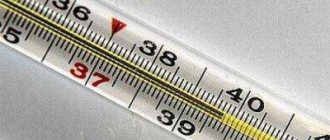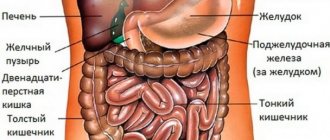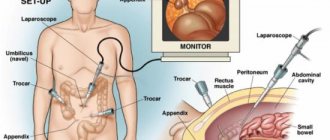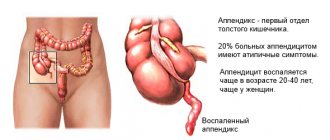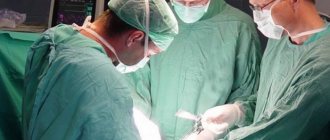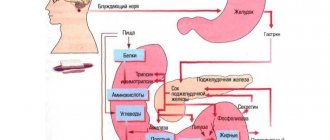Appendicitis is a serious illness that requires immediate surgical intervention. The operation is performed in several ways: abdominal and laparoscopy. The second method is considered more gentle; the rehabilitation period takes on average from 3 to 5 days.
One of the main symptoms of the disease is sharp pain in the abdominal area. Fever with appendicitis is a fairly common occurrence. In most cases it does not rise above 38 degrees. It is this symptom that largely helps doctors suspect appendicitis in a patient.
In today’s article we will look at when the temperature during appendicitis and after surgery is normal, and when it is necessary to urgently take action and change the treatment regimen.
Temperature in the preoperative period
Fever in humans is the body’s response to inflammatory processes. Most doctors claim that in this way the body “fights” viruses and bacteria. It is recommended to knock it down after the 38.5 degree mark.
Surgeons deal with the appendix every day in their medical practice. The disease is common in both children and adults.
https://youtu.be/dit6BBgqEVA
Diagnosis
When diagnosing the causes of hyperthermia after removal of the appendix, a blood test is prescribed to determine the presence of an inflammatory process. In this case, the number of leukocytes matters. But a blood test is not the only diagnostic method. Medical professionals often use:
- Diagnosis using an ultrasound machine. The procedure allows you to surgically examine the abdominal cavity without additional penetration and examine whether there is any damage to the internal organs. In the absence of damage, the site of the former attachment of the process of the cecum is examined. The area is examined for the presence of an inflammatory process.
Appendix on ultrasound
- The postoperative suture is examined. Sometimes there may be inflammation at the edges of the suture, which can cause prolonged fever.
- It is possible to biopsy the material through an open wound after removal of the appendix.
- Taking urine for analysis. The analysis provides information on the presence of leukocytes and possible problems with the genitourinary system.
The indicated diagnostic methods are sufficient to establish the exact cause of prolonged hyperthermia; additional studies are required in rare cases.
It should be understood that the values in the analyzes for men, women and children have different ranges and different variants of the norm.
Women, due to the way their bodies work, have a wider range of leukocytes than men. This is associated with a specific day of the menstrual cycle. In this regard, after 21 years of age, test results are divided based on gender.
When testing blood in children, the level of leukocytes is higher than normal not only in pathological conditions such as acute appendicitis, but also in other cases. The immune system of a child, in comparison with an adult’s body, is not as perfect. At the same time, infections and pathogenic environments more often enter the child’s body, which requires the immune system to increase the level of leukocytes.
Leukocytes in human blood
This is necessary to protect the body. If a child has appendicitis, the doctor must take blood for analysis not only before the operation, but also after it. The procedure is necessary to monitor your well-being and the proper healing process.
Temperature in the postoperative period
It must be taken into account that any surgical intervention is extremely stressful for the body. When removing the appendix, doctors work with the intestines. It's no secret that there are a lot of bacteria and microorganisms there.
To prevent their active reproduction, during the operation the patient is connected to an antibiotic drip. This in many cases helps to avoid complications.
Fever after appendicitis surgery is normal in most cases. It is necessary to monitor its indicators and the general condition of the patient.
Experts identify the following diagnostic signs of a temperature indicator:
- Subfebrile. Increases to 37.5-38 degrees. These indicators are absolutely normal on the first day after the operation. There's no point in knocking her down. This is how the body fights inflammatory processes.
- Febrile. Indicators from 38 to 39 degrees. Should alert the attending physician. In most cases, this means that the patient acquired an infection during the appendectomy. A blood test and antibiotics are required.
- Pyretic. From 39 degrees and above. This indicates a serious complication, often requiring repeated surgery.
- Hyperpyretic. Critical condition for the patient. The temperature rises to 41 degrees. Emergency assistance is required, often the patient is transferred to intensive care so that he is under the constant supervision of doctors 24 hours a day.
Classification of fever
To determine what exactly caused the system dysfunction, fever is classified:
- temperature 37 – 38 degrees – subfebrile;
- from 38 to 39 – febrile;
- from 39 to 40 – pyretic;
- from 40 and above – hyperpyretic.
To determine the graph of temperature fluctuations after removal of appendicitis, on the first day, drugs with antipyretic effects are not prescribed.
According to the type of fluctuations, hyperthermia is:
- constant (balancing within 1 degree);
- laxative (values are not stable, fluctuate by 1 – 2 degrees);
- intermittent – varies between low temperatures of 38 – 39 degrees;
- return – high numbers after a couple of days, decrease to normal limits;
- hectic - fever occurs with sudden temperature changes of 3 - 5 degrees;
- wavy - there is a smooth increase, decreasing to subfebrile values, with a smooth transition to normal limits;
- atypical – causeless increase;
- perverted - when the temperature rises in the morning, and in the evening there are no deviations from the norm;
- wavy in an acute form - short jerks without breaks between lifts;
- recurrent – after remissions, the fever returns.
How long does the fever last after surgery?
Medicine does not stand still. Every year, experts offer new methods of treating this or that disease.
Currently, removal of the appendix of the cecum is carried out using two methods:
- Cavity. The patient's abdominal cavity is cut open and the appendix is removed. The operation is performed under general anesthesia and takes about 1.5-2 hours. The rehabilitation process is quite long, it lasts 10-14 days. The patient spends the first few days in intensive care. This type of operation is characterized by an increase in the patient's temperature. Low-grade symptoms can last for 5-7 days.
- Laparoscopy. Several punctures are made in the patient’s abdomen, through which the appendix is removed. The operation lasts about 40 minutes–1 hour. On the 2nd day the patient can already walk, no stitches need to be removed. The temperature lasts for a maximum of 2-3 days, in most cases it is completely absent.
If the temperature after surgery to remove appendicitis lasts more than 10 days, this is considered a complication. The reasons may be as follows:
- During the operation the patient lost a lot of blood. In this case, an immediate transfusion is required, and special drug treatment is prescribed aimed at restoring the body's strength.
- The surgeon touched other organs, and inflammation occurs in them. The temperature can rise to its highest level; repeated surgery is often necessary to eliminate and correct the doctor’s mistake.
- During the operation, sterile working conditions were not observed, and an infection was introduced. You will have to take a long course of antibiotics.
- After the operation, the person’s immunity decreased and he “caught” a virus or bacterial infection. A consultation with a therapist will be required and antiviral drugs will be prescribed.
- In the wound itself, inflammation and suppuration occur. This happens if dressings are not done on time. The installation of drainage through which lymph and pus drain out helps to cope with the problem.
- The diet was disrupted. After removal of appendicitis, you need to eat right to normalize intestinal function. If this is not done, constipation appears, resulting in intoxication and fever.
Diagnostics
Symptoms of inflammation of the appendix are similar to other diseases of the abdominal organs. Difficulties arise in determining the location of the source of inflammation. Appendicitis is diagnosed using a set of techniques:
- Anamnesis collection. The doctor asks the patient about the nature of the pain, the time of its occurrence, the factors that caused the deterioration of the condition, and recent illnesses.
- Examination of the patient. There are palpation methods that can be used to identify an inflamed appendix . Diseases are determined by the characteristic reactions of the abdomen to touch.
- Laboratory blood tests. The acute form is characterized by the following signs: leukocytosis, a shift in the leukocyte formula to the left, an increase in changes over 3-4 hours.
- Ultrasound, CT scan of the abdominal organs. They allow you to see the inflamed organ and assess the degree of development of inflammation.
- Laparoscopy. It is carried out additionally if it is impossible to detect the disease using other methods . A small camera (endoscope) is used to examine the internal organs.
- X-ray contrast irrigoscopy of the large intestine helps to diagnose chronic inflammation of the appendix or with a non-standard clinical picture.
Prevention of complications after appendicitis removal
Is it possible to avoid fever after appendectomy? In many ways, everything depends on the individual characteristics of the body and the state of the immune system.
The first day after surgery, low-grade fever is present in 90% of cases. To avoid complications in the future, you need to follow the following doctor’s recommendations:
- If there is inflammation, be sure to take antibiotics.
- Follow a diet. Avoid constipation or diarrhea.
- Follow all instructions of specialists.
- Do dressings.
It is important! Do not allow peritonitis to occur. When the first signs of appendicitis appear, you should immediately consult a doctor. The development of destructive changes, as a rule, leads to serious complications and the occurrence of gangrenous appendicitis.
Duration of hyperthermia
The duration of temperature after surgery for appendicitis is above normal limits and should not exceed a decade, but if all signs indicate that the body is not recovering, it is worth focusing the doctor’s attention on this, since there is a more serious danger of developing postoperative pathology.
Reasons why the temperature does not stabilize after appendicitis removal a week later:
- large blood losses during removal of appendicitis;
- injuries to nearby organs;
- infection during surgery;
- against a background of suppressed immunity, acquisition of respiratory diseases;
- inflammation in the postoperative wound;
- if after surgery a drainage is placed in the wound;
- non-compliance with the recommended diet - adherence to the correct diet speeds up the healing process.
It is worth noting that if the drainage is in the wound for a long time, the temperature can persist for more than 10 days.
More serious causes are usually accompanied by additional symptoms:
- bowel dysfunction – mainly constipation;
- abdominal cramp;
- bouts of vomiting;
- excessive sweating;
- loss of consciousness.
Complications that maintain high temperature in the body can be caused by the negligence of medical personnel and insufficient competence of doctors. Before you decide to take a responsible step, you should familiarize yourself with the reputation of the clinic and doctor. Lack of sterility, improper dressing, earlier removal of sutures, drainage forgotten in the wound - reasons that can not only increase the readings on the thermometer, but also lead to more serious consequences.
Signs of the development of pathological hyper- and hypothermia
Surgeons are aware of the level of blood loss, which means they can control this process. With the development of acute temperature reactions due to blood loss, the patient is also accompanied by pale skin and cold sweat, and possibly an increase in heart rate and the number of breathing acts.
Minor blood loss is corrected by increasing the volume of blood volume through the infusion of physiological solutions. Significant blood loss may be accompanied by a decrease in body temperature to 35.8 degrees. Transfusions of transfusion media quickly restore the normal state of the body.
Most often, during an appendectomy, loops of the large or small intestine, as well as blood vessels, are damaged, against which the temperature initially rises in the postoperative period, but along with the level of loss of red blood cells, it begins to fall.
Such conditions are immediately recorded by the supervising doctors, as this is reflected in the dynamics of the general blood test. General weakness, nausea, and pale skin appear. Clots of dark blood are found in the stool, indicating bleeding from the gastrointestinal tract. Repeated surgery with suturing of hemorrhagic areas solves this problem.
